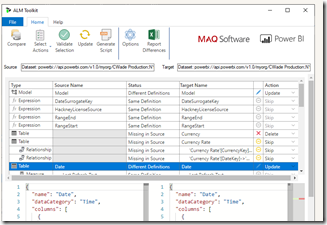
I would like to express my appreciation for 3 Power BI External Tools. From a DBA background, you always learn some backdoor queries to monitor a SQL Server system and the infrastructure behind it. Then, someone writes a tool to make it easier. This happened at a company I worked for that had Idera Diagnostic Manager and then Quest Spotlight. Having that historical metrics to compare to present day was invaluable.
Today, I work on models from Power BI with some originating in Analysis Services (model.bim file). To learn the backdoor queries would be to time consuming and redundant since the specific help I need has already been accomplished.

ALM Toolkit allows you to compare 2 models and push changes to the destination. This is equivalent to the schema compare tools available for SQL Server databases. The nice part is being able to actually see the specific objects/tables and column differences. This is not doable with pbix files.
Tabular Editor (2.x free and 3.x costs $) is used to edit a data model whether in Analysis Services or Power BI. It an amazing tool that has constant help from the Power BI community. I was able to find scripts to help with partitions as well as scripts to help with changing the connection string to a legacy connection originally used in Analysis Services ported to Power BI Premium. The Save To Folder even breaks the model down to json files for all objects that integrates with DevOps.
I have used DAX Studio for 2 main tasks today – looking at queries from Performance Analyzer in Power BI Desktop and the View Metrix to analyze the size of a model. Both are awesome functions to help with modeling, but that is only a fraction of what the tool can do. The View Metrix (Advanced Menu) uses VertiPaq Analyzer to take the model and show the size of overall model, table sizes and column sizes with a percent of a column compared to the whole database. You can pinpoint where to look to save on size. You can even connect to the model in the service (XMLA), the desktop model in memory or the deployed model in Analysis Services.
These tools are invaluable as a Power BI data modeler and I hope you have time to investigate their use in your environment.






